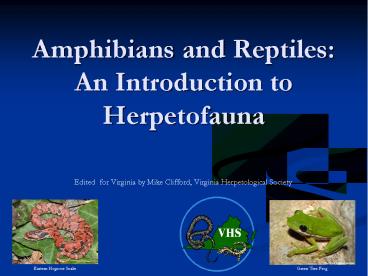Amphibians and Reptiles: An Introduction to Herpetofauna - PowerPoint PPT Presentation
Title:
Amphibians and Reptiles: An Introduction to Herpetofauna
Description:
Amphibians and Reptiles: An Introduction to Herpetofauna Compiled by the Davidson College Herpetology Laboratory Edited for Virginia by Mike Clifford, Virginia ... – PowerPoint PPT presentation
Number of Views:171
Avg rating:3.0/5.0
Title: Amphibians and Reptiles: An Introduction to Herpetofauna
1
Amphibians and Reptiles An Introduction to
Herpetofauna
- Compiled by the Davidson College Herpetology
Laboratory
Edited for Virginia by Mike Clifford, Virginia
Herpetological Society
2
Amphibians and Reptiles
- Regulate temperature from outside sources
- Ectothermic
Yellow-bellied Sliders
Northern Watersnake
3
Amphibians and Reptiles
- Secretive
- Can be very difficult to find
Northern Copperhead
4
Amphibians and Reptiles
- Important to their ecosystem
- Food for many other animals such as raccoons,
opossums, and birds - Control abundance of mice, rats, and bugs
Spotted Salamander
Green Salamander
Worm Snake
5
Amphibians
- 78 species in Virginia (51 salamanders 27 frogs
toads) - SE U.S.A. has the highest diversity of
salamanders in the world!
Grey Tree Frog
6
Amphibian Characteristics
- Skin
- Moist
- Breathe through their skin
- Good sense of smell
- Amphibians eat
- Insects
- Anything that will fit into their mouths
including other amphibians
7
Frogs
- Tadpoles when they are born
- Lose their tails as adults
- Two main types
- True Frogs
- Tree Frogs
- Toe-pads
Upland Chrous Frog
Pickerel Frog
8
Toads
- Similar to frogs
- Tail-less as adults
- Warty skin
- Have large glands behind each eye that produce
poison
American Toad
Fowlers Toad
9
Salamanders
- Plethodontids Dont have lungs and must breathe
entirely through their skin - Ambystomatids Have lungs, but can also breathe
through their skin - Salamanders can lay eggs in
- Streams
- Wetlands
- Soil
10
Amphibian Life Cycle
11
Amphibian Defense Methods
- Poison in skin
- Toads and Newts
- Producing large numbers of offspring
- Producing noisy squawks when attacked
Red-Spotted Newt
American Toad
Green Frog Tadpole
12
Reptiles
- 62 reptile species in Virginia
- 3 groups 30 snakes, 10 lizards including one
introduced, 22 turtles. - Antarctica only continent without reptiles
- First animal with a backbone to become
independent of water for breeding - Lays terrestrial eggs or gives birth to live young
13
Crocodilians
- American Alligator not native to Virginia but
is found just to the south in North Carolina
American Alligators
14
Turtles
- Backbone incorporated into their shell
- Lack teeth
- Has a beak similar to a bird
- Omnivorous Eats plants and animals
- Particularly enjoys insects and worms
Eastern Painted Turtles
15
What turtles are found in the ocean?
- Sea Turtles
- All are endangered
- Crush in Finding Nemo
Olive Ridley Sea Turtles
16
What turtles are found in ponds and rivers?
Common Musk Turtle
Eastern Painted Turtle
Snapping Turtle
Eastern Mud Turtle
River Cooter
17
What turtles can you find in your backyard?
- Box turtles!
18
Lizards
- Ears
- Distinguishing characteristic from snakes
- Variable and diverse
- Many islands have species that cannot be found
anywhere else on earth. - One group has lost their legs
- Called Glass Lizards
Slender Glass Lizard
Fence Lizard
Five-Lined Skink
Broadhead Skink
Slender Glass Lizard
19
Snakes
- 30 species in Virginia
- 3 venomous species
- Copperhead, Cottonmouth, Timber Rattlesnake.
- Most species are non-venomous
Scarlet Kingsnake non-venomous
Ringneck Snake non-venomous
Copperhead - venomous
Black Rat Snake non-venomous
20
Snakes
- All lack legs
- Lack ear openings
- Hear vibrations through the ground
- Shed their skin to grow
Timber Rattlesnake
Eastern Hog-nosed Snake
21
Snake Feeding
- Entirely carnivorous
- Swallow prey whole
- 2 methods to capture prey for consumption
- Constriction
- Poison
Eastern Cottonmouth eating a mouse
Northern Watersnake eating a fish
22
Conservation
- Many species are in decline
- More amphibian species are endangered than birds
or mammals - Few species are becoming more abundant
- Can you think of any reasons?
23
Causes of Declines
- Habitat destruction
- Building houses, parking lots, shopping centers
- Cutting down trees
- Filling in wetlands and ponds
- Pollution
- Trash and chemicals that are harmful to wild
animals
Photo by Steve Price
Photos by Steve Price
24
What can you do?
- Watch, but dont touch or keep any amphibians or
reptiles you find. - If you find an amphibian or reptile, let your
parents know. - Dont kill snakes
- Dont release any amphibian or reptile pet into
the wild
25
Questions?
Corn Snake






























